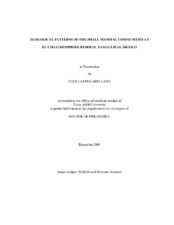| dc.description.abstract | Scarce knowledge of Neotropical small mammal communities prevents
experimental inquiry on the mechanisms structuring these communities. In this study, I
examined patterns of local assembly of the small mammal communities on the eastern
slopes of El Cielo Biosphere Reserve (ECBR) in Tamaulipas, Mexico, at two spatial
scales. At the landscape level I tested patterns of species co-occurrences between four
sites with a null model. At the local level I addressed floor microhabitat use, vertical
structure use and temporal partitioning. I studied these niche axes at two adjoining
forest types, Tropical Subdeciduous Forest (TSDF) and Cloud Forest (CF), that had
different structural complexity. Total trapping effort consisted of 19,712 trapnights
distributed over three years. In 1,365 capture events I recorded 789 individuals
representing 14 species. Abundant species, mostly Peromyscus species that are of
intermediate body size, co-occurred less often than expected by chance, whereas rare
species, mainly Reithrodontomys species of small size, occurred at random over study
sites. This pattern suggests that species interactions might be responsible for this non-random structure. Both the TSDF and CF had striking differences in both microhabitat
use and temporal partitioning. In the TSDF common species (>8 individuals) organized
along a microhabitat gradient from grassy/open areas to closed forest areas. Temporal
partitioning for the whole community was less than expected by chance with use of an
ad hoc null model. Species from ecotone/open areas avoided use of middle portions of
the night whereas the single forest species concentrated activity in this period. So, it is
plausible that predator avoidance strategies might have higher impact on temporal
partitioning as compared to competitive interactions. In high contrast the CF community
was codominated by two Peromyscus species that overlapped heavily in both their
microhabitat use and diel activity patterns. Ecological separation of these two species
probably occurs along a niche axis not considered in my study or might be facilitated by
their body mass difference. Overall, I provide the first account of community patterns
for small mammals at ECBR. These patterns can provide the basis for experimental
manipulations to ascertain mechanisms responsible for structure at these communities. | en |


